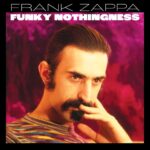Whenever an artist- or an artist’s estate- announces the impending release of a ‘lost album,’ inevitably it raises the question: why was it lost? The answer for Funky Nothingness begins with the artist, himself- Frank Zappa- whose legendary Vault of recordings is and has been something of treasure chamber for his heirs following Zappa’s passing, thirty years ago, in 1993. Since then, past and present Vaultmeisters- currently, it’s drummer, Joe Travers- have dutifully excavated and archived the Vault’s massive contents, and, for the better part of the last decade, with almost clockwork precision, assembled and issued several releases annually, curated by the Zappa Estate’s Ahmet Zappa.
There have been reissues, and box sets, and archived live recordings, and dozens upon dozens of previously unreleased tracks. A ‘lost album’ is no surprise. The mystery, after hearing it, is why it never surfaced sooner.
According to the excellent, included liner notes, Zappa’s sessions with a small, five-piece band in 1970 at the newly-opened Record Plant fell chronologically and creatively between his debut solo album, Hot Rats, and the eventual follow-up, Chunga’s Revenge. The resulting material was strong enough for Zappa to begin conceiving a sequence, starting with the acoustic blues, title-track opener (from a ’67 session, and a rare moment of Zappa on acoustic guitar). From there, Travers and Ahmet have done a very fine job of constructing a double-album approximation, with 11 songs, that marked where Zappa was at the time, and where the enigmatic artist was headed.
Two keys to the historical and artistic significance are Don “Sugarcane” Harris and Aynsley Dunbar. Harris was a mesmerizing violinist responsible for many of Hot Rats’ better instrumental moments. His soloing, paired with Zappa’s precise ferocity, is improvisation at the highest level. Here, it’s more of the same great stuff; with Sugarcane’s fabulous sawing, not to mention his mellifluously soulful vocals and swinging organ, a hub of most of the tracks.
Drummer Dunbar was newest to the fold. Given Zappa’s predilection for finding the perfect percussive fit for any project or band, the sessions, at times, feel almost like a forming kinship between Zappa and Dunbar. The extended pieces- “Tommy/Vincent Duo I” and “Tommy/Vincent Duo II”- reveal the quickly developing symbiosis of the pair. Clearly, this carries over to the sessions as a whole; the album is less progressive and classically-influenced than its Hot Rats predecessor, and zeroes in on more loosely constructed R&B and Blues, where grooves are of the essence.
There is an early version of “Chunga’s Revenge” and a few cuts, especially on the two bonus discs of the three-disc set, that foreshadow that album. The best of which is “Sharleena,” (which, ironically, would not actually make it onto the Chunga album) with a vintage mix by Frank that is this record’s summit; Zappa, Sugarcane, and Dunbar in peak performance. A close second is the closing “Twinkle Tits,” with magnificent improvisation and a trough-deep groove that follows a lovely baroque-in-the-tavern prelude, and could have easily sat alongside anything on Hot Rats.
Zappa would meet Flo and Eddie soon after these sessions, and shift to utilize the duo for a more theatrical incarnation of The Mothers. Thus Funky Nothingness would become just that, until revived magnificently from the Vault over five decades later. So much better late than lost forever.



No Comments comments associated with this post